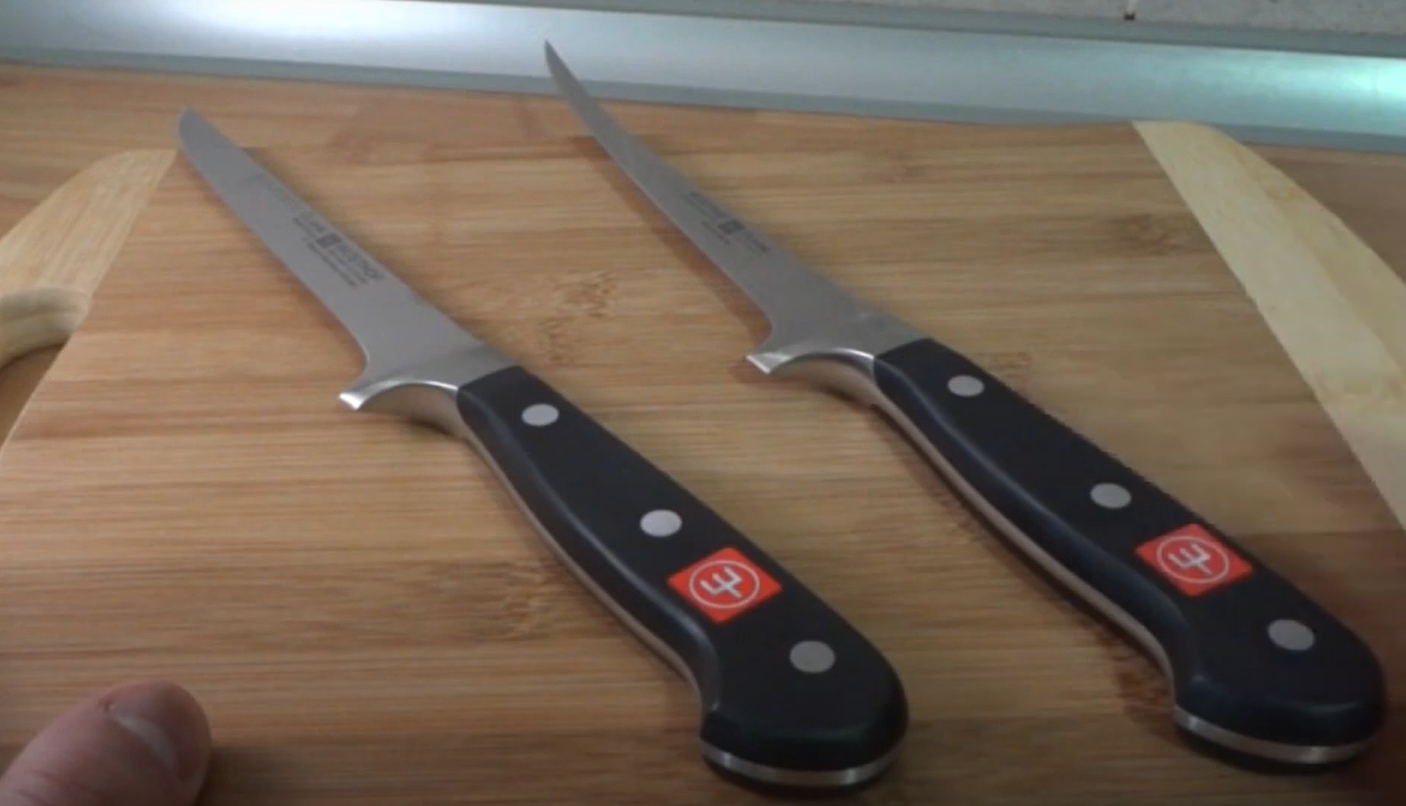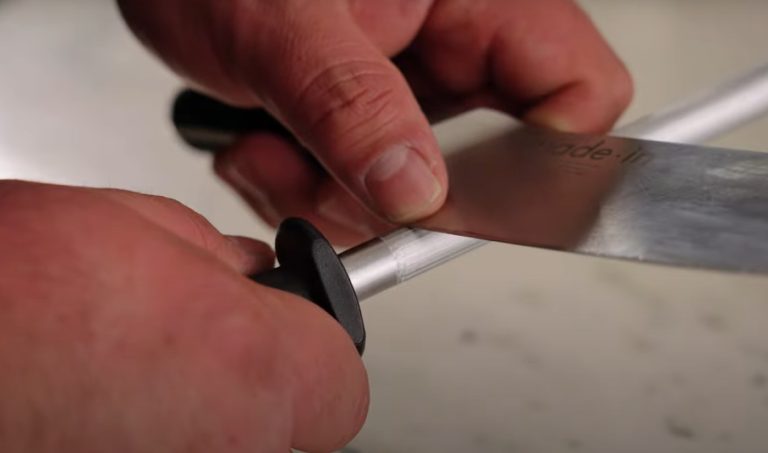Boning Knife vs Fillet Knife: The Ultimate Comparison Guide
A boning knife and a fillet knife serve unique roles in your kitchen. The boning knife, typically 5 to 7 inches with a slightly curved design, excels at separating meat from bones and is ideal for tougher cuts.
In contrast, the fillet knife features a longer, thinner blade that’s 5 to 9 inches, making it perfect for delicate fish preparation, allowing for precise, clean cuts.
While the boning knife offers versatility across various meats, the fillet knife’s flexibility is key for intricate fish tasks.
Understanding their distinct functions enables you to choose the right tool for your culinary needs. There’s more to explore about their specific uses and maintenance.
Key Takeaways
- Boning knives are designed for separating meat from bones, while fillet knives are specialized for preparing fish with delicate cuts.
- Boning knives typically have a blade length of 5 to 7 inches, whereas fillet knives range from 5 to 9 inches in length.
- Boning knives have a slightly curved, rigid blade for tough cuts, while fillet knives feature a thinner, more flexible blade for precision.
- Cleaning and maintaining both knives involve hand-washing and regular sharpening, but fillet knives require more frequent attention due to their delicate edges.
- Choosing between the two depends on the type of protein prepared; boning knives are versatile for meats, while fillet knives excel with fish.
Key Differences Between Boning Knife vs Fillet Knife
Boning knives typically have a blade length of 5 to 7 inches with a slightly curved design, making them adept at separating meat from bone.
They often feature high-carbon stainless steel blades known for sharpness and edge retention, which enhances their utility in various tasks.
In contrast, fillet knives range from 5 to 9 inches and feature a thinner, more flexible blade tailored for precise fish preparation.
The key differences lie in the blade’s stiffness and functionality. Boning knives possess a sturdier blade that excels at cutting through tough connective tissues, making them versatile for various meats, including poultry and beef.
Conversely, fillet knives are specifically designed for fish, requiring a razor-sharp edge with a long, shallow-angled bevel to facilitate smooth, gliding motions when filleting.
While a boning knife can often substitute in situations that require flexibility, misusing a fillet knife on other meats can damage its delicate blade.
This distinction reinforces that boning knives are more versatile, while fillet knives are specialized tools, optimized for the art of fish preparation.
Blade Shape and Design
When you compare boning knives and fillet knives, their distinct blade shapes and designs become immediately apparent. Boning knives typically feature a straight blade with a slight curve, which allows for precise cuts around bones and connective tissue. In contrast, fillet knives have a longer, thinner blade with a pronounced upward curve, designed specifically for maneuvering around fish bones and skin.
Here’s a quick comparison of their blade designs:
| Knife Type | Blade Shape | Key Features |
|---|---|---|
| Boning Knife | Slight curve | 5-7 inches, stiffer for stability |
| Fillet Knife | Pronounced curve | 5-9 inches, highly flexible |
| Material | High-carbon stainless steel | Sharpness and durability |
The blade design of boning knives emphasizes strength for tasks like deboning and trimming fat, while fillet knives prioritize a shallow-angled bevel for razor-sharp precision in slicing fish. If you’re preparing tougher meats, a flexible boning knife will provide the sturdiness needed, whereas for delicate fish preparation, a fillet knife’s flexibility is essential to navigate around fragile fish bones without damaging the flesh.
Flexibility and Control
The flexibility and control offered by boning and fillet knives greatly impact their effectiveness in various culinary tasks.
A boning knife typically strikes a balance between rigidity and slight flexibility, making it adept at separating meat from bones and cutting through tough connective tissue.
In contrast, a fillet knife features a thinner, more flexible blade, which allows you to execute intricate maneuvers around bones and skin—essential for preparing delicate fish fillets.
- Boning knives provide sturdiness for larger cuts, enhancing control.
- Fillet knives glide smoothly along fish bones, guaranteeing clean cuts.
- A flexible boning knife can double as a fillet knife for lighter tasks.
While the flexibility of a fillet knife guarantees precision and minimal damage to the flesh, a stiffer boning knife requires more force for tougher cuts.
This distinction means that although a flexible boning knife can tackle some filleting tasks, its rigidity limits its effectiveness for delicate slicing compared to a specialized fillet knife.
Purpose Of Boning Knife and Fillet Knife
The boning knife is primarily designed to separate meat from bones, making it versatile for various types of meat and fish.
With a blade length of 5 to 7 inches and a slightly curved edge, it excels at cutting through tough connective tissues and joints, allowing you to maneuver around bones with ease.
On the other hand, the fillet knife is specifically crafted for preparing fish, featuring a longer, thinner, and more flexible blade that typically ranges from 5 to 9 inches.
This design enables you to make precise cuts when filleting or skinning fish, minimizing resistance and reducing the risk of damaging the delicate flesh.
When to Use a Boning Knife?
You should use a boning knife when tackling meat preparation tasks that involve separating meat from bones, like deboning poultry or larger cuts.
Its sharp, pointed blade excels at slicing through tough tendons and joints, providing the precision needed for clean cuts.
Additionally, its versatility allows it to handle various proteins, though keep in mind that a fillet knife is often better suited for fish.
A boning knife is an essential tool for various meat preparation tasks, especially when deboning poultry. Its design allows you to make precise cuts around bones and joints, maximizing your meat yield.
For larger cuts of meat, such as beef or game, a sturdy boning knife is invaluable; it efficiently slices through tough sinew and connective tissue.
The pointed tip of the boning knife provides the dexterity needed for intricate tasks, like removing silver skin from pork or lamb. This feature enables you to maneuver easily around delicate areas, ensuring clean separations without damaging the meat.
When it comes to fish, a flexible boning knife can be particularly useful for separating meat from bones, although you might prefer a fillet knife for more delicate fish preparations.
The longer blade, typically ranging from 5 to 7 inches, allows for clean and even cuts, making the boning knife versatile for a variety of meat preparation tasks.
When to Use a Fillet Knife?
When you’re preparing whole fish, a fillet knife is your best tool for achieving clean, precise cuts with minimal resistance.
Its flexible blade excels at skinning and scaling, allowing you to navigate around bones without damaging the delicate flesh.
Whether you’re crafting sashimi or handling soft-fleshed varieties like trout, the fillet knife’s design guarantees you can execute each task with accuracy and care.
Precision is paramount in fish preparation, especially when you’re looking to achieve the best results with delicate species. A fillet knife is your go-to tool in these scenarios, as its thin and flexible blade allows you to navigate around bones and skin with ease.
This flexibility is essential for species like trout and flounder, where a steady hand and sharp edge are necessary to separate bones from meat without damaging the fish.
Consider using a fillet knife in these ideal situations:
- Filleting whole fish to maximize yield and minimize flesh damage.
- Skinning fish, where a thin blade provides clean separation without tearing.
- Preparing sashimi, where even, delicate slices are essential for presentation.
The corrosion-resistant steel of a fillet knife guarantees durability against moisture and salt exposure, making it perfectly suited for aquatic environments.
Unlike a boning knife, which is generally used for meat, the fillet knife excels in fish preparation. Its design allows for removing scales effortlessly, further enhancing your culinary experience.
Frequently Asked Questions
Is a Fillet Knife the Same as a Boning Knife?
You might think a fillet knife and a boning knife are the same, but they’re not. Each knife serves a distinct purpose, with unique blade designs tailored for specific tasks.
A fillet knife’s flexibility and thinner blade allow for precise cuts in fish, while a boning knife’s sturdiness and slightly curved blade excel at separating meat from bones.
Using the right tool not only makes your work easier but also enhances the quality of your results.
Can I Use a Boning Knife for Fish?
Yes, you can use a boning knife for fish. Just make sure it has a thin, flexible blade to effectively navigate around bones without damaging the flesh.
While a boning knife can handle deboning and skinning tasks, it may not offer the same precision as a dedicated fillet knife.
If you frequently prepare fish, investing in a fillet knife is advisable, but a boning knife can serve as a functional alternative when needed.
Do I Really Need a Boning Knife?
You don’t necessarily need a boning knife, but it can make your cooking experience much easier and more precise.
If you often prepare whole cuts of meat, poultry, or fish, its flexible blade allows you to separate meat from bones with accuracy.
You’ll find it helpful for trimming fat and skinning as well.
Investing in a high-quality boning knife can enhance your efficiency, reduce waste, and improve the overall quality of your meals.
What Is the Best Use of a Boning Knife?
The best use of a boning knife is for separating meat from bones with precision.
You’ll appreciate its maneuverability, typically ranging from 5 to 7 inches, as you navigate around joints and tendons.
Depending on your needs, you can choose between flexible or sturdy blades.
The pointed tip allows you to remove skin or fat without damaging the meat underneath, making it an essential tool for tasks like deboning poultry or trimming larger cuts.
Take Control of Your Culinary Symphony with the Right Knife
In choosing between a boning knife and a fillet knife, it’s essential to understand their distinct purposes and designs. Like a skilled musician selecting the right instrument, using the proper knife enhances your culinary precision and efficiency.
Whether you’re deboning meat or filleting fish, each knife serves a specific role. By recognizing their differences, you can elevate your cooking experience, ensuring that every cut is as intentional as a well-played note in a symphony.







